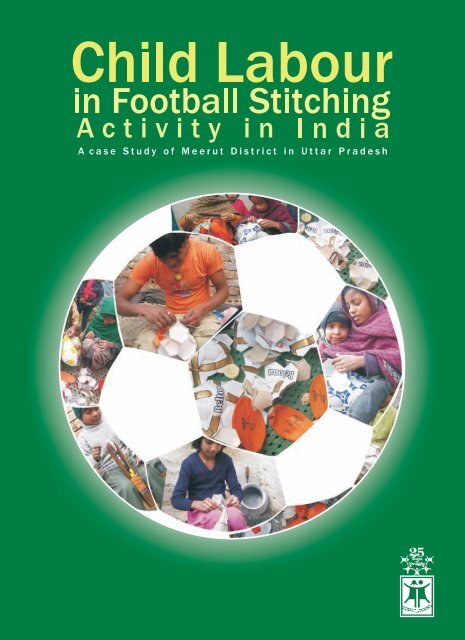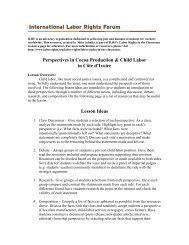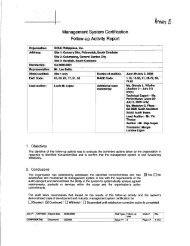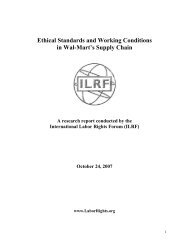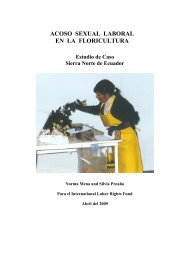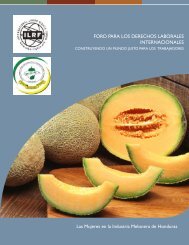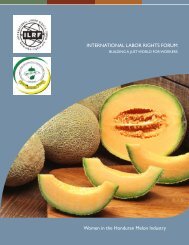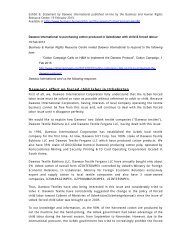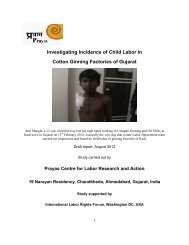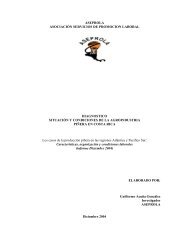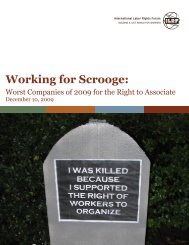Child Labour in Football Stitching
Child Labour in Football Stitching
Child Labour in Football Stitching
Create successful ePaper yourself
Turn your PDF publications into a flip-book with our unique Google optimized e-Paper software.
A c a s e S t u d y o f M e e r u t D i s t r i c t i n U t t a r P r a d e s h
Context of the Present Study<br />
The revelation of child labour engaged <strong>in</strong> football stitch<strong>in</strong>g activity <strong>in</strong> Sialkot region of Pakistan and<br />
Jullander and Meerut districts of India way back <strong>in</strong> 1995-96, prompted major stakeholders to <strong>in</strong>corporate<br />
effective mechanisms to work out ways and means to eradicated child labour from football stitch<strong>in</strong>g<br />
activity. Even after a decade of cont<strong>in</strong>uous implementation of World Federation of Sports Goods Industry<br />
(WFSGI) code of conduct for eradicat<strong>in</strong>g child labour from football stitch<strong>in</strong>g activity, several studies po<strong>in</strong>t<br />
out the presence of child labour <strong>in</strong> this activity especially <strong>in</strong> the unorganized home-based units of<br />
Jullander and Meerut <strong>in</strong> India. The guid<strong>in</strong>g market forces of acquir<strong>in</strong>g maximum profits by contractors/<br />
sub-contractors and manufacturers encourages employment of children <strong>in</strong> spite of the WFSGI code of<br />
conduct for its members.<br />
The observations of the studies (Refer Background Studies on <strong>Child</strong> <strong>Labour</strong> <strong>in</strong> <strong>Football</strong> Stitch<strong>in</strong>g Activity-<br />
Section II of the present Study) strengthens the viewpo<strong>in</strong>t that the vulnerability of stitchers community,<br />
due to prevail<strong>in</strong>g economic and social realities make it virtually impossible to elim<strong>in</strong>ate all cases of child<br />
labour from sports <strong>in</strong>dustry especially <strong>in</strong> the labour <strong>in</strong>tensive activity of football stitch<strong>in</strong>g even <strong>in</strong> highly<br />
monitored region of Jullander and Batala <strong>in</strong> Punjab. The condition is much worse <strong>in</strong> Meerut region which<br />
has received limited attention due to its highly unorganized sector as majority of football manufactur<strong>in</strong>g<br />
units are home based without the purview of any monitor<strong>in</strong>g mechanism.<br />
Objectives of Present study<br />
As a follow up of the observation of several research studies, news report<strong>in</strong>g and other media analysis,<br />
the present study exam<strong>in</strong>es to assess the presence of child labour <strong>in</strong> the football stitch<strong>in</strong>g activity <strong>in</strong><br />
Meerut district of India. Major objectives of the study are to exam<strong>in</strong>e:<br />
The extent of child labour <strong>in</strong> the appropriately selected villages and urban areas <strong>in</strong> Meerut district.<br />
Socio-economic profile of families whose children are engaged <strong>in</strong> the football stitch<strong>in</strong>g activity.<br />
Work<strong>in</strong>g conditions, <strong>in</strong>come and other health hazards associated with the football stitch<strong>in</strong>g activity.<br />
Identification of possible networks between sub contractors, contractors, sports manufacturers and<br />
buyers of match-grade footballs <strong>in</strong> Meerut district.<br />
Methodology and Research Organization<br />
The research study is based on exam<strong>in</strong>ation of previous studies and a field survey conducted dur<strong>in</strong>g<br />
November 2007- January 2008 <strong>in</strong> appropriately selected villages and urban areas of Meerut city.<br />
The study is based on both secondary data, field observations and primary data collected through a<br />
detailed field survey from appropriately selected households, children and other stakeholders. The<br />
secondary sources of <strong>in</strong>formation <strong>in</strong>clude several reports prepared by ILO, National <strong>Labour</strong> Institute-<br />
NOIDA, ICN, Tata Consultancy Services, Global March aga<strong>in</strong>st <strong>Child</strong> <strong>Labour</strong>, BBA and other media<br />
report<strong>in</strong>g. Information was also collected from several national and <strong>in</strong>ternational websites. A detailed<br />
literature review of the periodicals like annual reports, quarterly newsletters and other media<br />
publications was conducted. All documented records from various newspapers, journals and websites<br />
were scanned m<strong>in</strong>utely. The <strong>in</strong>formation was supplemented and validated on the basis of primary<br />
<strong>in</strong>formation collected dur<strong>in</strong>g the field visits and field surveys <strong>in</strong> the sample selected villages.<br />
The primary sources of <strong>in</strong>formation <strong>in</strong> selected villages of Meerut and Jullander were collected through<br />
field visits and an <strong>in</strong>tensive field survey, conducted with the help of questionnaires, focused group<br />
discussions and field observations. The selection of villages for the field survey and field visit was<br />
undertaken appropriately to have proper representative sample. (Refer Table No.1 and Map No.1). The<br />
map shows the spatial distribution of villages selected for the <strong>in</strong> depth survey.<br />
A c a s e S t u d y o f M e e r u t D i s t r i c t i n U t t a r P r a d e s h 1
A total of 79 households were randomly selected for survey <strong>in</strong> three villages and one urban locality <strong>in</strong><br />
Meerut district. The villages and urban locality was selected keep<strong>in</strong>g <strong>in</strong> view the <strong>in</strong>formation ascerta<strong>in</strong>ed<br />
from secondary sources <strong>in</strong>dicat<strong>in</strong>g prevalence of home-based units for football stitch<strong>in</strong>g activities. 69% of<br />
the rural households from the sample were hav<strong>in</strong>g home-based football stitch<strong>in</strong>g activity, while only 33%<br />
households from urban locality had football stitch<strong>in</strong>g activity. Thus a significant proportion of households<br />
from the adjacent villages were hav<strong>in</strong>g home-based football stitch<strong>in</strong>g activities as one of the major source<br />
of <strong>in</strong>come, which were not monitored by ant SGFI team <strong>in</strong> Meerut district.<br />
2<br />
A c a s e S t u d y o f M e e r u t D i s t r i c t i n U t t a r P r a d e s h
Sample Villages - Meerut<br />
% Households hav<strong>in</strong>ge Home Based <strong>Football</strong><br />
Stitch<strong>in</strong>g Units<br />
Urban Areas<br />
33<br />
All Villages<br />
69<br />
Siwal Khas ( Town )<br />
Dabathua<br />
33<br />
71<br />
Series1<br />
Buddh Vihar<br />
58<br />
Kamalpur<br />
73<br />
0 20 40 60 80<br />
Table No.1<br />
Sample Survey Details<br />
District<br />
Villages Selected<br />
for Field Survey<br />
Number of<br />
Households<br />
Surveyed<br />
Home Based<br />
Units/ Stitcher<br />
HH Observed<br />
No %<br />
Contractors/<br />
Sub<br />
Contractors<br />
Surveyed<br />
Meerut Kamalpur<br />
Buddh Vihar<br />
Dabathua<br />
Siwal Khas ( Town )<br />
33<br />
17<br />
17<br />
12<br />
24<br />
10<br />
12<br />
4<br />
73<br />
58<br />
71<br />
33<br />
5<br />
3<br />
2<br />
1<br />
All<br />
Villages<br />
Urban A.<br />
Source: Field Survey Data Conducted dur<strong>in</strong>g Novermber-2007 to January 2008<br />
79<br />
67<br />
12<br />
50<br />
46<br />
4<br />
63<br />
69<br />
33<br />
11<br />
10<br />
1<br />
The respondents covered dur<strong>in</strong>g the observation field visits and for an <strong>in</strong>-depth field survey <strong>in</strong>clude.<br />
· Randomly selected sample households.<br />
· Home-based Units hav<strong>in</strong>g football stitch<strong>in</strong>g activity<br />
· <strong>Child</strong>ren and family members work<strong>in</strong>g as football stitchers<br />
· Contractors / Sub contractors who deliver raw materials <strong>in</strong> the home based units.<br />
The methods of field survey <strong>in</strong>cluded field observation, group discussion and fill<strong>in</strong>g up of structured<br />
questionnaires for different stakeholders. The survey also <strong>in</strong>cluded an analysis of the family profile of<br />
child labourers engaged <strong>in</strong> football stitch<strong>in</strong>g activity. Indicators related to their socio-economic<br />
background were considered while collect<strong>in</strong>g the <strong>in</strong>formation (Refer Questionnaire-1).<br />
The field visits (for observation and survey) were preceded by an orientation programme imparted to the<br />
survey assistants for collect<strong>in</strong>g <strong>in</strong>formation from the field. The gender sensitization and child <strong>in</strong>teraction<br />
were particularly focused. The data collected through the primary and secondary sources were analyzed<br />
A c a s e S t u d y o f M e e r u t D i s t r i c t i n U t t a r P r a d e s h 3
statistically. The results were tested through sample design techniques. Diagrammatic representation of<br />
data through pie diagrams and bar graphs have been presented with the help of various measures of<br />
central tendency, deviations and other averages. The documentation is supported by photographs and<br />
<strong>in</strong>box <strong>in</strong>terviews, observation of officials, other stakeholders and target groups.<br />
Match-Grade <strong>Football</strong> Stitch<strong>in</strong>g Regions <strong>in</strong> India<br />
The match-grade football stitch<strong>in</strong>g activity has its roots <strong>in</strong> Sialkot region of Pakistan. After partitioned <strong>in</strong><br />
1947, many of Sialkot's bus<strong>in</strong>ess groups migrated across the border <strong>in</strong>to Punjab and Uttar Pradesh,<br />
settl<strong>in</strong>g <strong>in</strong> Jalandhar and Meerut city. (Refer Map No.2).<br />
Meerut<br />
Meerut is one of the important <strong>in</strong>dustrial towns of the western Uttar Pradesh. It is situated about 85 kms<br />
from Delhi. Sports manufactur<strong>in</strong>g units are ma<strong>in</strong>ly concentrated <strong>in</strong> and around Meerut city and adjacent<br />
villages. These <strong>in</strong>dustries came <strong>in</strong>to existence ma<strong>in</strong>ly after partition, when some families belong<strong>in</strong>g to<br />
Sialkot (presently <strong>in</strong> West Pakistan) migrated and settled <strong>in</strong> and around Meerut city. These families,<br />
hav<strong>in</strong>g sufficient knowledge of manufactur<strong>in</strong>g of sports items, started units to meet the local<br />
requirements <strong>in</strong>itially, however now sports equipments are also exported from Meerut. Meerut has one of<br />
the largest Muslim populations among the major cities of India (close to 45%). These communities are<br />
concentrated <strong>in</strong> Meerut city and its border villages<br />
Jalandhar<br />
Situated about 370 km north-west of New Delhi on National Highway, once popularly known as GT (Grand<br />
Trunk) Road between the rivers Ravi and Sutlej, is the city of Jalandhar. Basti Nau <strong>in</strong> the city, has one of the<br />
biggest sports goods markets. Industrial production of sports goods began on a small scale dur<strong>in</strong>g the late<br />
forties. Over the years, the sports goods <strong>in</strong>dustry has grown at an impressive rate and of late, Indian sports<br />
goods are also exported to different countries. Rough estimates suggest that today Jalandhar has more<br />
than one hundred <strong>in</strong>dustries and about 20,000 small-scale <strong>in</strong>dustries. About 60 per cent of the<br />
manufactured sports goods comprise of different k<strong>in</strong>ds of <strong>in</strong>flatable balls. Besides these, the other sports<br />
goods that are largely manufactured are badm<strong>in</strong>ton racquets and shuttle cocks, cricket bats and balls,<br />
different k<strong>in</strong>ds of gloves and protective equipment.<br />
Sports and <strong>Football</strong> Manufactur<strong>in</strong>g Units<br />
The sports bus<strong>in</strong>essmen started manufactur<strong>in</strong>g sports equipments <strong>in</strong> registered and unregistered<br />
manufactur<strong>in</strong>g units. Some of these units, by virtue of their long experience <strong>in</strong> the field, have built up a<br />
good brand name of their products, thereby gett<strong>in</strong>g orders from domestic market as well as from other<br />
countries. Major sports products manufactured are, Cricket Bats/ Stumps (wickets)/Balls/ Batt<strong>in</strong>g Pads/<br />
Wicket keep<strong>in</strong>g Gloves/ Helmets, box<strong>in</strong>g Gloves, punch<strong>in</strong>g gloves/ bags/ balls, Badm<strong>in</strong>ton Racket,<br />
Shuttle cock for <strong>in</strong>door & outdoor games, Badm<strong>in</strong>ton Nets, <strong>Football</strong>, Basketball, Volleyball, Handball ,<br />
hockey sticks/ balls/ pads/ halmets and tennis ball/ nets/ table. Most of India's sports goods are<br />
exported to the United K<strong>in</strong>gdom, The United States of America, Germany, France and Australia from these<br />
two regions. The Indian sports goods <strong>in</strong>dustry manufactures 318 items. However, major items that are<br />
exported are <strong>in</strong>flatable balls, hockey sticks and balls, cricket bats and balls and box<strong>in</strong>g gloves. Major<br />
manufacturers and distributors of sports equipments <strong>in</strong>clud<strong>in</strong>g match-grade footballs are concentrated<br />
<strong>in</strong> these two cities (Refer List of List of Manufacturers and Distributors of Sports Equipment from Jullander<br />
and Meerut).<br />
4<br />
A c a s e S t u d y o f M e e r u t D i s t r i c t i n U t t a r P r a d e s h
In these sports manufactur<strong>in</strong>g centers, three k<strong>in</strong>ds of establishments are usually found:<br />
i. Big establishments: These are generally geared to exports besides cater<strong>in</strong>g to the domestic<br />
market. Most of these are registered with regular monitor<strong>in</strong>g systems.<br />
ii.<br />
iii.<br />
Small establishments: These usually manufacture sports goods for the domestic market. Both<br />
the big establishments as well as the small establishments are registered either under the<br />
Factories Act, 1948, or under the Shops and Establishment Act of the state of Punjab.<br />
The unregistered units: These are found particularly <strong>in</strong> the urban pockets of Jalandhar and<br />
Meerut. These units are mostly small home-based units which are usually run by the family<br />
members, but at times with the help of a couple of hired employees. These units do not have a<br />
direct access to market <strong>in</strong>stead they are supplied raw materials through contractors/ sub<br />
contractors. It has been seen that many a times when the big establishments - especially<br />
exporters - are unable to cope with large orders from their foreign clients, these establishments<br />
distribute a share of the production to these small unregistered, home- based units through<br />
contractors/ sub contractors. These units do not fall under the purview of regular monitor<strong>in</strong>g<br />
from SGFI. <strong>Child</strong> labour and exploitation of labour are usually found <strong>in</strong> these unregistered<br />
household units, to maximize profits by contractors/ sub contractors and manufacturers.<br />
Types of <strong>Football</strong> Manufactur<strong>in</strong>g Centers<br />
Big Establishments<br />
Market (Domestic/International)<br />
Registered under Factory Act<br />
No <strong>Child</strong> <strong>Labour</strong><br />
Small Establishments<br />
Market (Domestic/International)<br />
Registered under Factory Act<br />
No <strong>Child</strong> <strong>Labour</strong><br />
Household Units<br />
Market (Domestic/International)<br />
Not Registered under Factory Act<br />
No monitor<strong>in</strong>g undertaken by SGFI<br />
<strong>Child</strong> <strong>Labour</strong><br />
Unhygienic & poor work<strong>in</strong>g conditions<br />
Background Studies on <strong>Child</strong> <strong>Labour</strong> <strong>in</strong> <strong>Football</strong> Stitch<strong>in</strong>g Activity:<br />
BBC and Other Newspaper Report<strong>in</strong>g- 1995-96<br />
The revelation of British Broadcast<strong>in</strong>g Corporation (BBC) and several <strong>in</strong>ternational newspapers <strong>in</strong> 1995-<br />
1996, that many of the world's match-grade footballs were be<strong>in</strong>g produced by children <strong>in</strong> the football<br />
manufactur<strong>in</strong>g center of Sialkot <strong>in</strong> Pakistan, created, furore among sports lov<strong>in</strong>g people, especially just<br />
before the commencement of 1996 European <strong>Football</strong> championship. An International <strong>Labour</strong><br />
Organization (ILO) study <strong>in</strong> the Sialkot region of Pakistan <strong>in</strong> 1996 estimated that more than 7,000<br />
Pakistani children between the ages of 5-14 years were stitch<strong>in</strong>g footballs on a regular, fulltime basis. The<br />
establishment of engagement of children <strong>in</strong> produc<strong>in</strong>g match-grade footballs forced the International<br />
Federation of <strong>Football</strong> Association (FIFA), World Federation of Sports Goods Industry (WFSGI), the<br />
International Confederation of Free Trade Unions (ICFTU), the International <strong>Labour</strong> Organization (ILO) and<br />
other lead<strong>in</strong>g football manufacturers such as Nike, Adidas, Reebok, Mitre (UK) and other lead<strong>in</strong>g<br />
manufacturers to adopt effective measures to stop us<strong>in</strong>g children to stitch the match-grade footballs <strong>in</strong><br />
Sialkot region of Pakistan, <strong>in</strong> order to save their brand image.<br />
A c a s e S t u d y o f M e e r u t D i s t r i c t i n U t t a r P r a d e s h 5
Christian Aid and SACCS Study Report- 1997<br />
Christian Aid (UK based NGO) <strong>in</strong> collaboration with the South Asian Coalition on <strong>Child</strong> Servitude (SACCS) <strong>in</strong><br />
their report <strong>in</strong> 1997, revealed that children <strong>in</strong> large numbers were also engaged <strong>in</strong> sports goods <strong>in</strong>dustry<br />
<strong>in</strong> India. A report released by SACCS In 1998 “A Sport<strong>in</strong>g Chance: Tackl<strong>in</strong>g <strong>Child</strong> Labor <strong>in</strong> India's Sports<br />
Goods Industry” on the eve of 1998 <strong>Football</strong> World Cup, estimated 25,000 to 30,000 children were<br />
engaged <strong>in</strong> Jallunder-Batala region of Punjab and Meerut region of Uttar Pradesh, the two major<br />
1<br />
manufactur<strong>in</strong>g centers of match-grade footballs <strong>in</strong> India . The reports were contested by the Sports<br />
Manufacturers Associations <strong>in</strong> India. However these reports had devastat<strong>in</strong>g consequences as major<br />
buyers like Adidas, Mitre and Umbro started question<strong>in</strong>g and seek<strong>in</strong>g assurances from the major football<br />
manufacturers of India that child labour is not used for the manufactur<strong>in</strong>g of footballs. A lead<strong>in</strong>g buyer<br />
company PUMA even took their bus<strong>in</strong>ess out of India <strong>in</strong> order to save their brand image.<br />
Follow-up Efforts by FIFA and SGFI<br />
The SACCS and Christian Aid reports prompted manufacturers to <strong>in</strong>itiate several measures to salvage the<br />
image of the sports manufacturers <strong>in</strong> the eyes of FIFA, WFSGI and other branded <strong>in</strong>ternational buyers of<br />
match-grade footballs. The measures adopted were:<br />
Commission<strong>in</strong>g of <strong>in</strong>dependent research study on the prevalence of child labour <strong>in</strong> sports <strong>in</strong>dustry.<br />
The research was commissioned by the Federation of Industrial Commerce and Chambers of India<br />
(FICCI a lead<strong>in</strong>g bus<strong>in</strong>ess partners <strong>in</strong> India). The research was conducted by the reputed researchers<br />
of Government of India, V.V. Giri, National <strong>Labour</strong> Institute <strong>in</strong> Jullender region of Punjab. Their research<br />
report, '<strong>Child</strong> labour <strong>in</strong> the sports goods <strong>in</strong>dustry; Jalandhar, A Case Study', was published <strong>in</strong><br />
2<br />
September 1998 . The report established the presence of about 10,000 children below 14 years of<br />
age <strong>in</strong> the stitch<strong>in</strong>g of footballs <strong>in</strong> the district of Jullendar <strong>in</strong> Punjab state of India. It revealed that<br />
around 1,350 children were engaged as full time labourers, while the rest were engaged as part time<br />
along with school<strong>in</strong>g for the stitch<strong>in</strong>g of footballs. Other produc<strong>in</strong>g areas like Meerut <strong>in</strong> Uttar Pradesh<br />
were not <strong>in</strong>cluded <strong>in</strong> the study. The report also provided a wealth of <strong>in</strong>formation on the wages, health<br />
situation and other socio-economic conditions of the community engaged for football stitch<strong>in</strong>g.<br />
Formation of Sports Goods Foundation of India (SGFI) <strong>in</strong> 1998. Initially SGFI was conglomeration of 25<br />
sports goods exporters which has now <strong>in</strong>creased to 32 members. The SGFI was supported by FIFA<br />
from Ist January 2000 for <strong>in</strong>itiat<strong>in</strong>g social protection and monitor<strong>in</strong>g programme to oversee the<br />
activities of football manufactur<strong>in</strong>g units and condition of stitchers <strong>in</strong> India. The monitor<strong>in</strong>g<br />
programme was prepared <strong>in</strong> consultation with the Centre for Research <strong>in</strong> Rural and Industrial<br />
Development (CRRID-Chandigarh), WFSGI, Save the <strong>Child</strong>ren and UNICEF. It <strong>in</strong>volved Swiss firm called<br />
Société Générale de Surveillance (SGS) to monitor the manufactur<strong>in</strong>g units. As per the guidel<strong>in</strong>es<br />
contractors were supposed to list details of football stitchers -name, age, location-of the home-based<br />
stitchers hired by them etc;. SGS then cross-checks the locations and details of stitchers made<br />
available by the manufacturers by mak<strong>in</strong>g <strong>in</strong>spections and sudden home visits. SGFI members<br />
contribute 0.25% of their earn<strong>in</strong>gs from football exports every month for social protection and<br />
monitor<strong>in</strong>g programmes. Under the social protection programme, the SGFI · has also adopted four<br />
"transitional" schools set up under the National <strong>Child</strong> <strong>Labour</strong> Project to help work<strong>in</strong>g children enter the<br />
school system.<br />
3<br />
The manufacturer of footballs was entered <strong>in</strong>to an agreement for adoption of WFSGI code of conduct .<br />
The code of conduct <strong>in</strong>cludes;<br />
· No person shall be employed at an age younger than 15 (or 14 where the law of the country of<br />
manufacture allows) or younger than the age for complet<strong>in</strong>g compulsory education <strong>in</strong> the<br />
country of manufacture where such age is higher than 15.<br />
1. Christian Aid, A sport<strong>in</strong>g chance - Tackl<strong>in</strong>g child labour <strong>in</strong> India's sports goods <strong>in</strong>dustry, May 1997, page 3.<br />
2. V. V. Giri National <strong>Labour</strong> Institute, <strong>Child</strong> labour <strong>in</strong> the sports goods <strong>in</strong>dustry: Jalandhar, A Case Study, Noida, September 1998. This survey was jo<strong>in</strong>tly<br />
supported by FICCI and ILO-IPEC.<br />
3. WFSGI Code of Conduct – Guid<strong>in</strong>g Pr<strong>in</strong>ciples, http://www.wfsgi.org/_wfsgi/new_site/about_us/codes/code.pdf.<br />
6<br />
A c a s e S t u d y o f M e e r u t D i s t r i c t i n U t t a r P r a d e s h
· On the issues of monitor<strong>in</strong>g and verification, the code notes that: Members are encouraged<br />
to establish their own <strong>in</strong>ternal management systems to monitor the standards outl<strong>in</strong>ed <strong>in</strong><br />
their own code of conduct and to implement action plans for cont<strong>in</strong>uous improvements <strong>in</strong><br />
factory work<strong>in</strong>g conditions <strong>in</strong> their own operations and those who supply them. Members<br />
are also encouraged to have factories monitored by appropriately qualified external third<br />
party organizations.<br />
India Committee of Netherlands (ICN) Report - 2000<br />
The India Committee of the Netherlands (ICN) presented a report <strong>in</strong> June 2000 entitled “The Dark Side of<br />
4<br />
<strong>Football</strong>: <strong>Child</strong> and adult labour <strong>in</strong> India's football <strong>in</strong>dustry and the role of FIFA ”. The report highlighted<br />
the pathetic conditions of child labour <strong>in</strong> sports <strong>in</strong>dustry <strong>in</strong> Punjab <strong>in</strong> spite of the efforts undertaken by<br />
SGFI. The summary of the report shows that many children are still work<strong>in</strong>g <strong>in</strong> and around the cities of<br />
Jalandhar and Batala <strong>in</strong> Punjab. It <strong>in</strong>dicated that wages are often still far below the official m<strong>in</strong>imum wage<br />
of Rs. 82 (2US$) per day, and that women earn on an average Rs. 4 or 5 less than men for stitch<strong>in</strong>g per<br />
ball. This report also criticizes the present FIFA-sponsored monitor<strong>in</strong>g system implemented by SGFI. The<br />
report concluded that the contractual agreements between the ISL (the licens<strong>in</strong>g organization of FIFA)<br />
and all licensed football import<strong>in</strong>g companies, who buy their footballs, are violated on the issues of<br />
(hid<strong>in</strong>g) child labour, wages below the official m<strong>in</strong>imum rates, misuse of advances paid to workers,<br />
obstacles to the right to organize for seek<strong>in</strong>g appropriate wages, exemption from exist<strong>in</strong>g labour<br />
5<br />
legislation and lack<strong>in</strong>g health standards and sanitary facilities .<br />
Global March aga<strong>in</strong>st <strong>Child</strong> <strong>Labour</strong> Report, May<br />
2002<br />
The Global March aga<strong>in</strong>st <strong>Child</strong> <strong>Labour</strong> Reports – 2002 entitled “<strong>Football</strong> Dreams Stitched with<br />
<strong>Child</strong>ren's Hands: India, Ch<strong>in</strong>a and Pakistan still Harbour <strong>Child</strong> <strong>Labour</strong>ers and Unfair <strong>Labour</strong> Conditions”<br />
6<br />
were released to the press, just before the commencement of the <strong>Football</strong> World Cup 2002 . The report<br />
created ripples among the football sports lovers and questioned the efforts of FIFA, WFSGI, ICFTU and ILO<br />
<strong>in</strong> elim<strong>in</strong>at<strong>in</strong>g child labour from football stitch<strong>in</strong>g activities. Several football manufacturers and buyers<br />
were put on back foot with the revelations.<br />
The reports revealed that the efforts to improve labour conditions through the monitor<strong>in</strong>g and<br />
rehabilitation programs of FIFA, UNICEF, ILO and the SGFI have thus far yielded only limited results,<br />
particularly <strong>in</strong> India and Pakistan, the key centers for football stitch<strong>in</strong>g. The hands of children are still<br />
employed to stitch footballs, even at the price of their education and often their health. Adult football<br />
stitchers are still receiv<strong>in</strong>g less than the m<strong>in</strong>imum wage, even though the footballs they stitch are sold at<br />
higher price. Women still face discrim<strong>in</strong>ation <strong>in</strong> wages, often earn<strong>in</strong>g five rupees less than men. The<br />
report <strong>in</strong>dicated lack of freedom for collective barga<strong>in</strong><strong>in</strong>g by the stitchers to seek better wages and<br />
work<strong>in</strong>g conditions. The report on Pakistan revealed that child labor was <strong>in</strong>volved <strong>in</strong> the stitch<strong>in</strong>g of Coca<br />
Cola and Adidas footballs both of which were major sponsors of the FIFA 2002 World Cup, <strong>in</strong> the<br />
peripheral areas of Sialkot region of Pakistan, contrary to the claims that Sialkot sport <strong>in</strong>dustry has been<br />
freed from child labour after strict monitor<strong>in</strong>g by FIFA and other lead<strong>in</strong>g football manufacturers.<br />
4. India Committee of the Netherlands – June 2000, “The dark side of football: <strong>Child</strong> and adult labour <strong>in</strong> India's football <strong>in</strong>dustry and the role of<br />
FIFA. http://www.antenna.nl/liw/iv.html<br />
5. Ibid.<br />
6. Global March aga<strong>in</strong>st <strong>Child</strong> <strong>Labour</strong>, May 2003 “<strong>Football</strong> dreams stitched with children's hands: India, Ch<strong>in</strong>a and Pakistan Still Harbour <strong>Child</strong><br />
<strong>Labour</strong>ers and Unfair <strong>Labour</strong> Conditions”.<br />
7. Tata Consultancy Services, Social Sector Group, May 2002 ,"<strong>Child</strong> <strong>Labour</strong> and <strong>Labour</strong> Rights <strong>in</strong> the Sport<strong>in</strong>g Goods Industry: A Case for<br />
Corporate Social Responsibility"<br />
A c a s e S t u d y o f M e e r u t D i s t r i c t i n U t t a r P r a d e s h 7
Tata Consultancy Services (TCS) Report- Social<br />
Sector Group – May 2002<br />
International Committee of the Neitherlands (ICN) contracted the services of the Social Sector Group, TCS<br />
to do an objective assessment of the ground realities as a follow up of ICN -2000 study. The TCS study<br />
entitled "<strong>Child</strong> <strong>Labour</strong> and <strong>Labour</strong> Rights <strong>in</strong> the Sport<strong>in</strong>g Goods Industry: A Case for Corporate Social<br />
Responsibility" was aimed to (re)exam<strong>in</strong>e the issue/problem of child labour and other labour standards <strong>in</strong><br />
7<br />
the football <strong>in</strong>dustry <strong>in</strong> India .<br />
Major f<strong>in</strong>d<strong>in</strong>gs from the study reiterated the presence of child labour <strong>in</strong> football stitch<strong>in</strong>g activity even <strong>in</strong><br />
Jullandar and Batala areas of Punjab, <strong>in</strong> spite of tall claims of FIFA supported SGFI monitor<strong>in</strong>g<br />
mechanism. Wage disparity between workers <strong>in</strong> registered and non-registered units was huge. Gender<br />
variation <strong>in</strong> wages <strong>in</strong> the home-based units was also observed by the study.<br />
BBA STUDY 2006 on <strong>Child</strong> <strong>Labour</strong> <strong>in</strong> Sports Industry<br />
<strong>in</strong> Meerut , Uttar Pradesh<br />
The exposure of child labour engaged <strong>in</strong> sports <strong>in</strong>dustry of Meerut city and its surround<strong>in</strong>g regions was<br />
highlighted by the an Indian NGO, Bachpan Bachao Andolan (BBA, Save <strong>Child</strong>hood Campaign) for the first<br />
time on the eve of FIFA World Cup 2006.<br />
Kailash Satyarthi, Chairperson of BBA stated that “big branded companies outsource work to small<br />
contractors, who take unfair advantage of the poor <strong>in</strong> villages and small towns like those around Meerut,<br />
who then employ little children to churn out footballs at the cost of their health and education. <strong>Child</strong>ren as<br />
young as six are employed <strong>in</strong> the football-manufactur<strong>in</strong>g <strong>in</strong>dustry right across Meerut city and adjacent<br />
villages.<br />
On the eve of FIFA World Cup 2006, the <strong>Child</strong>ren work<strong>in</strong>g as football stitchers <strong>in</strong> factories and home based<br />
units <strong>in</strong> Meerut district, sent a memorandum to Fédération Internationale de <strong>Football</strong> Association (FIFA)<br />
and other football associations request<strong>in</strong>g sports goods companies, “to ensure that no child was<br />
employed <strong>in</strong> the football-mak<strong>in</strong>g <strong>in</strong>dustry. They have also appealed to these bodies to make sure that<br />
former work<strong>in</strong>g children are properly rehabilitated. We wish that football becomes an <strong>in</strong>strument of<br />
pleasure, harmony and unity for all <strong>in</strong> the world. However, we appeal that this should not happen at the<br />
cost of our childhood, education and development.<br />
Tehalka Report<br />
Shal<strong>in</strong>i S<strong>in</strong>gh of Tehalka Journal published a comprehensive report entitled “No Free Kicks <strong>in</strong> Meerut” <strong>in</strong><br />
July 2006 on the child labour engaged <strong>in</strong> football stitch<strong>in</strong>g activities <strong>in</strong> Meerut district. The report sums up<br />
the condition of stitchers of football communities as follows:<br />
““The cost of the beer bottle that three friends can knock back watch<strong>in</strong>g a World Cup match at a<br />
South Delhi pub, is what Ishwari's family of 17 makes <strong>in</strong> a month — just around Rs 1,000<br />
(US$25) stitch<strong>in</strong>g footballs <strong>in</strong> Kherkhi village near Meerut. Wak<strong>in</strong>g up early to deal with the<br />
household chores, the women and older children of the family settle down, after the men go out<br />
to work, to an arduous seven-hour rout<strong>in</strong>e. Ishwari, who is <strong>in</strong> her sixties, says the men don't<br />
m<strong>in</strong>d their women do<strong>in</strong>g this work s<strong>in</strong>ce it doesn't <strong>in</strong>volve their leav<strong>in</strong>g the house except to br<strong>in</strong>g<br />
raw materials and deliver the f<strong>in</strong>ished goods. The family's one f<strong>in</strong>ancial buffer is its small plot of<br />
agricultural land — most others <strong>in</strong> the football-stitch<strong>in</strong>g trade <strong>in</strong> the 50-odd villages around<br />
Meerut have no such additional sources of <strong>in</strong>come.”<br />
8<br />
A c a s e S t u d y o f M e e r u t D i s t r i c t i n U t t a r P r a d e s h
<strong>Football</strong> Stitch<strong>in</strong>g Activity: Work<strong>in</strong>g Environment<br />
and Process<br />
<strong>Football</strong> stitch<strong>in</strong>g activity is usually home based activity, where all family members work together <strong>in</strong> homebased<br />
units usually located <strong>in</strong> the home of the family members. S<strong>in</strong>ce the family has few rooms even for<br />
their requirements, the work place is adjusted with<strong>in</strong> the liv<strong>in</strong>g rooms. Majority of the rooms are too small<br />
and the presence of work<strong>in</strong>g table for the stitch<strong>in</strong>g further makes it congested. Rooms are usually made<br />
of mud structure and light <strong>in</strong> the rooms are <strong>in</strong>appropriate for stitch<strong>in</strong>g activity. In the absence of electricity<br />
the activity of stitch<strong>in</strong>g is undertaken <strong>in</strong> dark and d<strong>in</strong>gy rooms which affect eyes. All family members sit <strong>in</strong><br />
the congested room together and cont<strong>in</strong>ue the work activity for 8 to 10 hours per day dur<strong>in</strong>g the peak<br />
seasons. A sample of day and night activity of women and children is given below.<br />
Day & Night Activity of Women & <strong>Child</strong>ren Engaged <strong>in</strong> Foot Stitch<strong>in</strong>g Activity<br />
WOMEN<br />
3<br />
6<br />
2<br />
1<br />
1<br />
3<br />
8<br />
Cook<strong>in</strong>g Clean<strong>in</strong>g Other Domestic Course <strong>Child</strong> Rear<strong>in</strong>g Stitch<strong>in</strong>g Rest Sleep<strong>in</strong>g<br />
Work<strong>in</strong>g <strong>Child</strong>ren<br />
2<br />
8<br />
7<br />
4<br />
3<br />
Help<strong>in</strong>g Domestic Cource <strong>Football</strong> Stitch<strong>in</strong>g Play<strong>in</strong>g Rest/no activity Sleeep<strong>in</strong>g<br />
A c a s e S t u d y o f M e e r u t D i s t r i c t i n U t t a r P r a d e s h 9
School Go<strong>in</strong>g & Work<strong>in</strong>g <strong>Child</strong>ren<br />
7<br />
1<br />
3<br />
3<br />
6<br />
4<br />
Help<strong>in</strong>g Domestic Cource <strong>Football</strong> Stitch<strong>in</strong>g Play<strong>in</strong>g Rest/no activity School Go<strong>in</strong>g Sleep<strong>in</strong>g<br />
Process of <strong>Football</strong> Mak<strong>in</strong>g<br />
Raw materials like thread, wax, cut leather pieces and design of football is provided by the contractor/ sub<br />
contractor to the households. Leather pieces are cut <strong>in</strong> the ma<strong>in</strong> manufactur<strong>in</strong>g unit with the help of<br />
mach<strong>in</strong>es. Home based activity for complet<strong>in</strong>g the football is<br />
· Wax<strong>in</strong>g Thread<br />
· Wax for harden<strong>in</strong>g the thread<br />
· Stitch<strong>in</strong>g the <strong>in</strong>dividual leather/ synthetic panels as per design<br />
· Stitch<strong>in</strong>g half balls ( Locally called as Khokha )<br />
· Jo<strong>in</strong><strong>in</strong>g two halves of a ball and <strong>in</strong>sert<strong>in</strong>g rubber tube<br />
· Stitch<strong>in</strong>g bl<strong>in</strong>d parts of the ball. ( It requires careful punctur<strong>in</strong>g the holes , so that rubber tube is<br />
not punctured )<br />
The process observed <strong>in</strong>dicated that children (6+ years) and women are regularly hunched over a wooden<br />
apparatus for hour's together, dart<strong>in</strong>g needles <strong>in</strong> and out of the colourful pentagonal pieces of<br />
rubberized/ leather/ synthetic material. In this process of <strong>in</strong>sert<strong>in</strong>g needles nimble f<strong>in</strong>gers of children are<br />
usually punctured from sharp needles. F<strong>in</strong>gers have cuts from the waxed silk thread that is used to suture<br />
the material. The whole process is undertaken <strong>in</strong> unhygienic conditions, where the light is dim. Thus there<br />
is <strong>in</strong>evitable damage to the sight, brought on by the long hours of arduous squ<strong>in</strong>t<strong>in</strong>g.<br />
10<br />
A c a s e S t u d y o f M e e r u t D i s t r i c t i n U t t a r P r a d e s h
Process of <strong>Football</strong> Mak<strong>in</strong>g<br />
undertaken at home based units<br />
Wax<strong>in</strong>g of<br />
Thread<br />
Mostly by<br />
Women & <strong>Child</strong>re<br />
Harden<strong>in</strong>g of<br />
Thread<br />
Mostly by<br />
Adult Men &<br />
Women<br />
Stitch<strong>in</strong>g the<br />
<strong>in</strong>dividual<br />
leather<br />
Mostly by<br />
<strong>Child</strong>ren<br />
& Women<br />
Stitch<strong>in</strong>g half<br />
balls<br />
Mostly by<br />
<strong>Child</strong>ren<br />
& Women<br />
Jo<strong>in</strong><strong>in</strong>g two<br />
halves of a ball<br />
and <strong>in</strong>sert<strong>in</strong>g<br />
rubber tube<br />
Mostly by<br />
Adults Men<br />
& Women<br />
Magnitude of <strong>Child</strong> <strong>Labour</strong> <strong>in</strong> <strong>Football</strong> Stitch<strong>in</strong>g<br />
Activity <strong>in</strong> Meerut<br />
The survey results po<strong>in</strong>t out the prevalence of child labour <strong>in</strong> football stitch<strong>in</strong>g activities <strong>in</strong> the selected<br />
sample households. 9% of boys and 18% of girls aged 6-17 years were pursu<strong>in</strong>g full time football stitch<strong>in</strong>g<br />
activity. A significant proportion of boys and girls ( 43% and 57% respectively were engaged <strong>in</strong> both<br />
football stitch<strong>in</strong>g as well as school go<strong>in</strong>g activity. However the results also <strong>in</strong>dicated that 84% boys and<br />
67% girls were attend<strong>in</strong>g schools, which seems to be comparatively better situation. The role BBA<br />
activists who have started Bal Mitra Gaon ( <strong>Child</strong> Friendly Village ) campaign seems to have worked as<br />
even among Muslim households the trend of send<strong>in</strong>g children to schools has <strong>in</strong>creased. However gender<br />
gap <strong>in</strong> school enrolments still persists as proportion of girl school go<strong>in</strong>g children were lesser compared to<br />
boys. ( Refer Table No. and Graphs )<br />
<strong>Child</strong>ren Aged 6-17 Years among Sample Households<br />
Boys<br />
All<br />
9<br />
43<br />
84<br />
Siwal Khas<br />
7<br />
21<br />
86<br />
Dabathua<br />
9<br />
48<br />
65<br />
% Only Work<strong>in</strong>g<br />
% School Go<strong>in</strong>g<br />
Budd Vihar<br />
9<br />
52<br />
86<br />
% Both work<strong>in</strong>g and school Go<strong>in</strong>g<br />
Kamalpur<br />
9<br />
44<br />
86<br />
0 20 40 60 80 100<br />
A c a s e S t u d y o f M e e r u t D i s t r i c t i n U t t a r P r a d e s h 11
Girls<br />
All<br />
18<br />
57<br />
67<br />
Siwal Khas<br />
8<br />
38<br />
71<br />
Dabathua<br />
17<br />
65<br />
61<br />
% Only Work<strong>in</strong>g<br />
% School Go<strong>in</strong>g<br />
Budd Vihar<br />
17<br />
63<br />
62<br />
% Both work<strong>in</strong>g and school Go<strong>in</strong>g<br />
Kamalpur<br />
23<br />
57<br />
68<br />
0 20 40 60 80<br />
Table<br />
Village<br />
<strong>Child</strong>ren <strong>in</strong><br />
6-17 Age<br />
% Both<br />
work<strong>in</strong>g<br />
% School<br />
Go<strong>in</strong>g<br />
% Only<br />
Work<strong>in</strong>g<br />
Group<br />
and school<br />
Go<strong>in</strong>g<br />
Boys Girls Boys Girls Boys Girls Boys Girls<br />
Kamalpur 43 44 44 57 86 68 9 23<br />
Budd<br />
Vihar<br />
21 24 52 62 86 63 9 17<br />
Dabathua 21 23 48 61 81 65 9 17<br />
Siwal<br />
Khas<br />
14 13 21 38 86 71 7 8<br />
ALL 99 104 43 57 84 67 9 18<br />
Source: Field survey data collected from sample households<br />
<strong>Football</strong> Stitchers Profile<br />
Traditionally and culturally football stitch<strong>in</strong>g is be<strong>in</strong>g done by Muslims and landless backward and<br />
scheduled caste labourers (called as dalits). Workers for the football stitch<strong>in</strong>g activity usually belong to<br />
economically poor sections among Muslim population and particular scheduled caste community among<br />
8.<br />
the H<strong>in</strong>du and Sikh faiths Majority of these workers are landless depend<strong>in</strong>g solely on labour activity. It is<br />
difficult to get labour assignment throughout the year <strong>in</strong> the agricultural and construction sector, hence<br />
these people have to depend on other activities. The sports bus<strong>in</strong>essmen exploit these conditions and<br />
engage their family for football stitch<strong>in</strong>g at wages lower than the stipulated rates.<br />
8. The prevail<strong>in</strong>g cultural and traditional beliefs among the H<strong>in</strong>dus do not allow people to touch leather items, hence Muslim and Scheduled caste<br />
community are usually engaged for football stitch<strong>in</strong>g activity.<br />
12<br />
A c a s e S t u d y o f M e e r u t D i s t r i c t i n U t t a r P r a d e s h
These labourer have no barga<strong>in</strong><strong>in</strong>g power as they have no other work for susta<strong>in</strong><strong>in</strong>g their livelihood, so<br />
whatever work at whatever wages fixed by the contractors are acceptable to them. Wages are paid per<br />
piece basis, hence the whole family <strong>in</strong>clud<strong>in</strong>g children work together for stitch<strong>in</strong>g footballs <strong>in</strong> order to<br />
stitch as many footballs as possible.<br />
The demand for footballs dur<strong>in</strong>g World Cup/ Cont<strong>in</strong>ental football cup or any other tournament <strong>in</strong>crease<br />
sharply. The registered units are unable to meet the demand from the registered units, which usually is<br />
monitored by the SGFI. Hence contractors/sub contractors are always on the look out to identify<br />
vulnerable families to undertake the football stitch<strong>in</strong>g activity to bridge the demand and supply gap for<br />
the footballs. The contractors/ sub contractors provide raw materials to the families for complet<strong>in</strong>g the<br />
stitch<strong>in</strong>g of the footballs <strong>in</strong> family units. The demand sometimes goes as high as mak<strong>in</strong>g 20,000 to<br />
25000 footballs per day. Even <strong>in</strong> this rare, bumper event, the wage per unit is hiked by a mere 50 paise.<br />
With no union, barga<strong>in</strong><strong>in</strong>g power or alternate means of sustenance, the villagers accept whatever wages<br />
are paid. If they refuse to work at the go<strong>in</strong>g rate, someone else will readily agree to do so for less — this way,<br />
at least, they're earn<strong>in</strong>g “someth<strong>in</strong>g<br />
Occupational Classification and <strong>Child</strong> <strong>Labour</strong> <strong>in</strong><br />
<strong>Football</strong> Stitch<strong>in</strong>g<br />
An analysis of occupation wise proportion of households hav<strong>in</strong>g home-based football stitch<strong>in</strong>g activity<br />
testifies that the activity is more prevalent among landless labourers, followed by households hav<strong>in</strong>g<br />
small trade activities. The football stitch<strong>in</strong>g units were fewer among farm<strong>in</strong>g and service households.<br />
Thus the results suggest close relationship between households have no land and pure dependence on<br />
labour activity with the prevalence of football stitch<strong>in</strong>g units. The percent of girl children engaged <strong>in</strong><br />
football stitch<strong>in</strong>g activity was much higher among labourers and small traders as compared to farm<strong>in</strong>g<br />
and service community. As expected all children from farm<strong>in</strong>g and service community were attend<strong>in</strong>g<br />
schools. Gender gap <strong>in</strong> send<strong>in</strong>g children to schools was exceptionally high among labourers. Thus the<br />
study po<strong>in</strong>ts out vulnerability of labourers and small traders for engag<strong>in</strong>g children <strong>in</strong> the football stitch<strong>in</strong>g<br />
activity. (Refer Table No. and Graph No. )<br />
Table<br />
Occupational Groups and Magnitude of <strong>Child</strong>ren <strong>in</strong> <strong>Football</strong> Stitch<strong>in</strong>g <strong>in</strong> Meerut<br />
Occupation<br />
%Hous<br />
eholds<br />
hav<strong>in</strong>g<br />
<strong>Football</strong><br />
Stitch<strong>in</strong>g<br />
Activity<br />
<strong>Child</strong>ren <strong>in</strong><br />
6-18 Age<br />
Both<br />
work<strong>in</strong>g<br />
and school<br />
Go<strong>in</strong>g<br />
School<br />
Go<strong>in</strong>g<br />
Only Work<strong>in</strong>g<br />
Boys Girls Boys Girls Boys Girls Boys Girls<br />
Farm<strong>in</strong>g 33 4 6 50 100 100<br />
<strong>Labour</strong> 84 37 39 68 74 84 26 16 31<br />
Small<br />
trade<br />
61 41 43 44 53 78 81 7 16<br />
service 22 17 16 19 100 100<br />
ALL 63 99 104 43 57 84 67 9 19<br />
A c a s e S t u d y o f M e e r u t D i s t r i c t i n U t t a r P r a d e s h 13
Boys<br />
All<br />
9<br />
43<br />
84<br />
Service<br />
100<br />
% Only Work<strong>in</strong>g<br />
Small Trade<br />
7<br />
44<br />
78<br />
% School Go<strong>in</strong>g<br />
<strong>Labour</strong><br />
16<br />
68<br />
84<br />
% Both work<strong>in</strong>g and<br />
school Go<strong>in</strong>g<br />
Farm<strong>in</strong>g<br />
100<br />
0 20 40 60 80 100<br />
Girls<br />
All<br />
19<br />
57<br />
67<br />
Service<br />
19<br />
100<br />
% Only Work<strong>in</strong>g<br />
Small Trade<br />
16<br />
53<br />
81<br />
% School Go<strong>in</strong>g<br />
<strong>Labour</strong><br />
31<br />
26<br />
74<br />
% Both work<strong>in</strong>g and<br />
school Go<strong>in</strong>g<br />
Farm<strong>in</strong>g<br />
50<br />
100<br />
0 20 40 60 80 100<br />
Income Classification and <strong>Child</strong> <strong>Labour</strong> <strong>in</strong> football<br />
Stitch<strong>in</strong>g<br />
An analysis of <strong>in</strong>come of households and presence of home-based football stitch<strong>in</strong>g units <strong>in</strong> the<br />
households depicts close relationship as majority of households hav<strong>in</strong>g less than Rs 3000 <strong>in</strong>come per<br />
month had football stitch<strong>in</strong>g units. Households hav<strong>in</strong>g less than Rs 1000 <strong>in</strong>come per month engaged all<br />
children for fulltime work for football stitch<strong>in</strong>g activity. Similarly households with less <strong>in</strong>come had lesser<br />
proportion of children enrolled <strong>in</strong> schools, thus <strong>in</strong>creas<strong>in</strong>g their vulnerability for employ<strong>in</strong>g them <strong>in</strong> full<br />
time football stitch<strong>in</strong>g. ( Refer Table No. and graph No )<br />
14<br />
A c a s e S t u d y o f M e e r u t D i s t r i c t i n U t t a r P r a d e s h
Table<br />
Income Levels of Households and <strong>Child</strong> <strong>Labour</strong> Magnitude <strong>in</strong> Meerut<br />
Income<br />
Group<br />
%House<br />
holds<br />
hav<strong>in</strong>g<br />
<strong>Football</strong><br />
Stitch<strong>in</strong>g<br />
Activity<br />
<strong>Child</strong>ren <strong>in</strong><br />
6-18 Age<br />
Both<br />
work<strong>in</strong>g<br />
and school<br />
Go<strong>in</strong>g<br />
School<br />
Go<strong>in</strong>g<br />
Only Work<strong>in</strong>g<br />
Boys Girls Boys Girls Boys Girls Boys Girls<br />
Less than 100 4 5 100 100<br />
1000<br />
1000 - 100 25 27 36 44 76 44 12 30<br />
2000<br />
2001 - 91 30 31 57 68 87 58 7 16<br />
3000<br />
3001 - 26 27 26 56 69 96 85<br />
4000<br />
Above 9 13 15 15 40 100 100<br />
4000<br />
ALL 63 99 104 43 57 84 67 9 18<br />
Even after a full day's work the children can only produce a maximum of two footballs and earn at best Rs.<br />
3-5 per football, which is 40 times less than its retail price. They are paid a pittance for their labour” Entire<br />
families, <strong>in</strong>clud<strong>in</strong>g m<strong>in</strong>or children, are often <strong>in</strong>volved <strong>in</strong> stitch<strong>in</strong>g footballs. Six to seven members of a<br />
family work long hours to produce around 10 balls; they barely manage to earn Rs 30-40 a day. If a stitch<br />
comes undone, the contractors deduct the repair cost from the labourers' wages. In case of severe<br />
damage, such as a punctured bladder, the entire cost is recovered from the makers.<br />
The World Cup season or any other tournament forces children to be taken out of school; the <strong>in</strong>creased<br />
demand has necessitated their be<strong>in</strong>g kept home to stitch the balls that will fetch their families an<br />
additional <strong>in</strong>come. Murid Khan says that there is only one primary school <strong>in</strong> the village. Private schools<br />
charge, at a m<strong>in</strong>imum cost of Rs 500 per child each month, <strong>in</strong>clusive of fees and stationary which is<br />
unaffordable. With more than three children per average household, provid<strong>in</strong>g for their education is hard.<br />
Work is the one viable option many families see for their kids. Eight-year-old Sunita, who helps her mother,<br />
sister and brother stitch footballs, says she was enrolled <strong>in</strong> Class 3 but was unable to attend school due to<br />
constant pressure from parents to help them <strong>in</strong> football stitch<strong>in</strong>g.<br />
Most of the football stitchers are under-paid. The pay depends of the contractor or their skills, however,<br />
the study shows that about half of the stitchers <strong>in</strong> India are liv<strong>in</strong>g below the poverty l<strong>in</strong>e. About 90% of the<br />
households belong to the 'untouchables' (scheduled castes <strong>in</strong> India) or Dalits and marg<strong>in</strong>alized Muslim<br />
community.<br />
The observations of the above studies strengthens the viewpo<strong>in</strong>t that the vulnerability of stitchers<br />
community due to prevail<strong>in</strong>g economic and social realities make it virtually impossible to elim<strong>in</strong>ate all<br />
cases of child labour from sports <strong>in</strong>dustry especially <strong>in</strong> the labour <strong>in</strong>tensive activity of football stitch<strong>in</strong>g.<br />
The guid<strong>in</strong>g market forces of acquir<strong>in</strong>g maximum profits by contractors/ sub-contractors and<br />
manufacturers encourages employment of children <strong>in</strong> spite of the WFSGI code of conduct for its<br />
members.<br />
A c a s e S t u d y o f M e e r u t D i s t r i c t i n U t t a r P r a d e s h 15
Health Hazards among football stitchers<br />
The survey conducted also highlighted stitch<strong>in</strong>g as major health hazard as children were found with cuts<br />
on their f<strong>in</strong>gers that had become septic. S<strong>in</strong>ce their earn<strong>in</strong>gs are per item produced, the children try to<br />
stitch as fast as they can with no fixed hours. They have to sit for long hours <strong>in</strong> a hunched position that<br />
often causes them to suffer severe backache. Inadequate light<strong>in</strong>g <strong>in</strong> the work place had ru<strong>in</strong>ed the<br />
eyesight. Many of them suffer from loss of eyesight, chronic back and neck pa<strong>in</strong>s, cuts on their f<strong>in</strong>gers and<br />
even deformation of their f<strong>in</strong>gers. For younger children, these conditions can last for their lifetime s<strong>in</strong>ce<br />
proper treatment is usually not given. Due to high morbidity, some respondents stated that they had to<br />
leave the football stitch<strong>in</strong>g job for some months to rega<strong>in</strong> their health. There is no public healthcare<br />
system and workers have to depend on private medical care from the Meerut city, which is expensive and<br />
beyond their reach.<br />
"I have been stitch<strong>in</strong>g footballs for as long as I can remember," confided Geeta, a young girl from<br />
Kamalpur village, who estimated her age to be between 10 and 12 years old. "My hands are constantly <strong>in</strong><br />
pa<strong>in</strong>. It feels like they are burn<strong>in</strong>g.<br />
Table<br />
Health and Morbidity among <strong>Football</strong> Stitchers <strong>in</strong> Meerut<br />
Nature of Health Problems<br />
Average Number Hours devoted for<br />
<strong>Football</strong> stitch<strong>in</strong>g per day.<br />
4-5 Hours<br />
5-6 Hours<br />
6-7 Hours<br />
Above 7 Hours<br />
21<br />
35<br />
24<br />
30<br />
Percent Adult<br />
Respondents<br />
35<br />
20<br />
25<br />
20<br />
Observed f<strong>in</strong>ger cuts 10 35<br />
Suffer<strong>in</strong>g from cont<strong>in</strong>uous backache 45 35<br />
Tir<strong>in</strong>g of Eyes 65 39<br />
Pa<strong>in</strong> <strong>in</strong> hands and f<strong>in</strong>gers 85 79<br />
Feel<strong>in</strong>g allover pa<strong>in</strong> 35 26<br />
Percent <strong>Child</strong>ren<br />
Respondents<br />
To make matters worse, there is no public health care system.<br />
16<br />
A c a s e S t u d y o f M e e r u t D i s t r i c t i n U t t a r P r a d e s h
Identification of Network of Contractors,<br />
Manufacturer and Buyers<br />
The situation is compounded by the fact that the workers are only <strong>in</strong> touch with the contractor, who is the<br />
middleman. They have little idea about who owns the f<strong>in</strong>al product, or the dest<strong>in</strong>ation of the footballs that<br />
they stitch. Moreover, s<strong>in</strong>ce there is no written agreement, the child laborers/ adult labourer do not get<br />
any benefits laid down <strong>in</strong> the law. These home-based units are never monitored by the SGFI.<br />
A c a s e S t u d y o f M e e r u t D i s t r i c t i n U t t a r P r a d e s h 17
18<br />
A c a s e S t u d y o f M e e r u t D i s t r i c t i n U t t a r P r a d e s h
List of <strong>Football</strong> Suppliers – Meerut<br />
Sahni Sports<br />
Address: 632/2, Jagriti Vihar, Meerut,<br />
Uttar Pradesh - 250 004, India<br />
Phone: +(91)-(121)-4003164/2603708<br />
Fax: +(91)-(121)-4006149<br />
Website: http://www.sahnisports.com<br />
New Jandial and Company<br />
Address: A-5, Sports Complex, Delhi Road,<br />
Meerut, Uttar Pradesh - 250 002, India<br />
Phone: +(91)-(121)-2530414<br />
Website: http://www.<strong>in</strong>diamart.com/newjandial<br />
Garg Sports International<br />
Chaitanya Puram, Near Indira Gate,<br />
Navchandi, Meerut, Uttar Pradesh - 250 002, India<br />
Phone: +(91)-(121)-2700237/3298723<br />
Website: http://www.<strong>in</strong>diamart.com/gargsports<br />
Greenland Enterprises<br />
72-73 Rajvansh Vihar, Sarai Kazi Village Road,<br />
Garh Road, Meerut, Uttar Pradesh - 250 003, India<br />
Phone: +(91)-(121)-3258922<br />
Fax: +(91)-(121)-2763465<br />
Website: http://www.<strong>in</strong>diamart.com/greenland<br />
Competent Sales<br />
24. Chippi Tank Begum Bridge Road, Meerut,<br />
Uttar Pradesh - 250 001, India<br />
Phone: +(91)-(121)-2643236<br />
Hans Rubber And Sports Ltd.<br />
Address: Guru Nanak Nagar, Delhi Road,<br />
Meerut, Uttar Pradesh - 250 002, India<br />
Phone: +(91)-(121)-2513677/2510077/2511247<br />
Fax: +(91)-(121)-2510827<br />
Website: http://www.<strong>in</strong>diamart.com/company/400546/<br />
Jay Export House<br />
Address: 53/8, Shastri Nagar, Meerut,<br />
Uttar Pradesh - 250 004, India<br />
Phone: +(91)-(121)-2772202/4000832<br />
Fax: +(91)-(121)-2772202<br />
Website: http://www.<strong>in</strong>diamart.com/jayexports<br />
Stag International<br />
Address: A-19/20, Udyog Puram, Partapur,<br />
Delhi Road, Meerut, Uttar Pradesh - 250 002, India<br />
Phone: +(91)-(121)-2440976/2440993/2441035<br />
Fax: +(91)-(121)-2441009/2660095<br />
Website: http://www.stag<strong>in</strong>ternational.net/<br />
A c a s e S t u d y o f M e e r u t D i s t r i c t i n U t t a r P r a d e s h 19
Maxwel Exporters<br />
Address: B-5, Sports Compex,<br />
Delhi Road, P.O. Box - 366, Meerut,<br />
Uttar Pradesh - 250 002, India<br />
Phone: +(91)-(121)-2510459/2520854<br />
Fax: +(91)-(121)-2511783<br />
Website: http://www.maxwelexporter.com/soccer-tra<strong>in</strong><strong>in</strong>g-aids.html<br />
National Sports<br />
Address: B- 1 Sports Complex, Delhi Road,<br />
Meerut, Uttar Pradesh - 250 001, India<br />
Phone: +(91)-(121)-2512148/2400574<br />
Fax: +(91)-(121)-2512275<br />
Website: http://www.national-sport.com/<br />
List of <strong>Football</strong> Suppliers- Jalandhar<br />
Behari Lal And Company<br />
Address: 66, Basti Nau, Jalandhar,<br />
Punjab - 144 002, India<br />
Phone: +(91)-(181)-2252590<br />
Fax: +(91)-(181)-2258370<br />
Website: http://www.<strong>in</strong>diamart.com/belco<br />
Sports Syndicate, Jalandhar<br />
Address: Basti Road, Jalandhar,<br />
Punjab - 144 001, India<br />
Phone: +(91)-(181)-2650347/2650716/2650795/309099<br />
Fax: +(91)-(181)-2651412/5081709<br />
Website: http://<strong>in</strong>dia.sportgoods<strong>in</strong>dia.com/<br />
Sports Syndicate<br />
Address: Basti Road, Jalandhar,<br />
Punjab - 144 001, India<br />
Phone: +(91)-(181)-2650347/2650716/2650795/3090992/320200<br />
Fax: +(91)-(181)-2651412/5081709<br />
Website: http://www.<strong>in</strong>diamart.com/sports-syndicate<br />
Khorana Sports Industries<br />
Address: Basti Nau, Jalandhar,<br />
Punjab - 144 002, India<br />
Phone: +(91)-(181)-2255559<br />
Website:<br />
http://www.<strong>in</strong>diamart.com/khoranasports<br />
Golden Sports and Games<br />
Address: W. X. -53, Basti Nau,<br />
Jalandhar, Punjab - 144 002, India<br />
Phone: +(91)-(181)-2253293<br />
Fax: +(91)-(181)-2209969<br />
Website: http://www.<strong>in</strong>diamart.com/goldensports-games<br />
20<br />
A c a s e S t u d y o f M e e r u t D i s t r i c t i n U t t a r P r a d e s h
Ceela International<br />
Address: Ceela Complex, B-11, Sports and Surgical Complex,<br />
Kapurthala Road, Jalandhar, Punjab - 144 021, India<br />
Phone: +(91)-(181)-2651243/2650806/2650250 Fax: +(91)-(181)-2650053<br />
Website: http://www.<strong>in</strong>diamart.com/ceela<br />
Goodw<strong>in</strong> Sports, Jalandhar<br />
Address: 15-16, Dilbagh Nagar Extension,<br />
Jalandhar, Punjab - 144 002, India<br />
Phone: +(91)-(181)-2203304/2209307<br />
Fax: +(91)-(181)-2250665<br />
Website: http://www.sportsgoodsexporters<strong>in</strong>dia.com/<br />
Em Cee Cee Sports Agencies Pvt. Ltd.<br />
Address: Jonex House, Sodal Road,<br />
Jalandhar, Punjab - 144 004, India<br />
Phone: +(91)-(181)-5065134/5065130<br />
Fax: +(91)-(181)-2293743<br />
Website: http://www.jonexsports.com/<br />
Union Sports International<br />
Address: New Rasila Nagar, Basti Danishmandan,<br />
Jalandhar, Punjab - 144 002, India<br />
Phone: +(91)-(181)-9876085819<br />
Website: http://www.<strong>in</strong>diamart.com/unionsports<br />
Soccer International Ltd.<br />
Address: Basti Sheikh Road,<br />
Jalandhar, Punjab - 144 002, India<br />
Phone: +(91)-(181)-2254118/2250416/5095904/5091806<br />
Fax: +(91)-(181)-2252398/5085329<br />
Website: http://www.<strong>in</strong>diamart.com/soccer<strong>in</strong>ternational/<br />
Crimson International<br />
Address: C-90, Sports and Surgical Complex,<br />
Jalandhar, Punjab - 144 001, India<br />
Phone: +(91)-(181)-2651020/6541020<br />
Fax: +(91)-(181)-5013915<br />
Website: http://www.<strong>in</strong>diamart.com/crimson<strong>in</strong>t<br />
Big Boss Exim Company<br />
Address: Amar Nagar,<br />
Jalandhar, Punjab - 144 701, India<br />
Phone: +(91)-(98)-72329842<br />
Website: http://www.<strong>in</strong>diamart.com/company/716730/<br />
Rugby Exports India<br />
Address: G. T. Road, Bye Pass,<br />
Jalandhar, Punjab - 144 004, India<br />
Phone: +(91)-(181)-2294008<br />
Fax: +(91)-(181)-2294010<br />
Website: http://www.<strong>in</strong>diamart.com/company/625192/<br />
Bhami International<br />
Address: Khurla K<strong>in</strong>gra, Jalandhar, Punjab - 144 013, India<br />
Phone: +(91)-(181)-2685321 Fax: +(91)-(181)-2685321<br />
Website: http://www.<strong>in</strong>diamart.com/company/871203/<br />
A c a s e S t u d y o f M e e r u t D i s t r i c t i n U t t a r P r a d e s h 21
Anand Gymnastic Works<br />
Address: Basti Nau, Jalandhar,<br />
Punjab - 144 001, India<br />
Phone: +(91)-(181)-2202944<br />
Website: http://www.<strong>in</strong>diamart.com/company/764124/<br />
Ishar Dass Mahajan and Sons<br />
Address: 1/1, Basti Nau, Jalandhar,<br />
Punjab - 144 002, India<br />
Phone: +(91)-(181)-2255198/2255328<br />
Fax: +(91)-(181)-2255030<br />
Website: http://www.<strong>in</strong>diamart.com/company/441970/<br />
Beat All Sports<br />
Address: S/114-115 Industrial Area,<br />
Jalandhar, Punjab - 144 004, India<br />
Phone: +(91)-(181)-2290075/2295184<br />
Fax: +(91)-(181)-2291046<br />
Website: http://www.<strong>in</strong>diamart.com/company/378211/<br />
Gomti Agrico<br />
Address: Near Jalandhar Model School, Tanda Road,<br />
Jalandhar, Punjab - 144 004, India<br />
Phone: +(91)-(181)-2291116/2283116<br />
Fax: +(91)-(181)-2291116<br />
Website: http://www.<strong>in</strong>diamart.com/company/926575/<br />
Avran Exports<br />
Address: 17, Shakti Nagar, Jalandhar,<br />
Punjab - 144 002, India<br />
Phone: +(91)-(181)-5075244<br />
Fax: +(91)-(181)-2404050<br />
Amar Nath Mahajan & Sons<br />
Address: S-128, Industrial Area,<br />
Jalandhar, Punjab - 144 004, India<br />
Phone: +(91)-(181)-5089097<br />
Fax: +(91)-(181)-5058860<br />
Bhaizada & Son<br />
Address: S. 6, Industrial Area, Jalandhar,<br />
Punjab - 144 004, India<br />
Phone: +(91)-(181)-291841/293123<br />
Fax: +(91)-(181)-290749<br />
Kamal Brothers Jalandhar<br />
Address: 18, B, Ganesh Nagar, Basti Nau,<br />
Jalandhar, Punjab - 144 002, India<br />
Phone: +(91)-(181)-253103<br />
Fax: +(91)-(181)-254557<br />
D. C. M. Sports Industries<br />
Address: 82, F. C. I. Colony, Near G.T. B. Nagar,<br />
Jalandhar, Punjab - 144 003, India<br />
Phone: +(91)-(181)-2270268<br />
Fax: +(91)-(181)-2270268<br />
22<br />
A c a s e S t u d y o f M e e r u t D i s t r i c t i n U t t a r P r a d e s h
Hans Raj Mahajan and Sons<br />
Address: G.T. Road, Suranussi, Jalandhar,<br />
Punjab - 144 027, India<br />
Phone: +(91)-(181)-2670701/2671549/2671262/2671263/2672077<br />
Fax: +(91)-(181)-2670702/2402507<br />
Website: http://www.hansraj-<strong>in</strong>dia.com/<br />
Sports Syndicate, Tra<strong>in</strong><strong>in</strong>g Aids<br />
Address: Basti Road, Jalandhar,<br />
Punjab - 144 001, India<br />
Phone: +(91)-(181)-2650347/2650716/2650795/3090992/320200<br />
Fax: +(91)-(181)-2651412/5081709<br />
Website: http://www.<strong>in</strong>diamart.com/sstra<strong>in</strong><strong>in</strong>gaids<br />
A c a s e S t u d y o f M e e r u t D i s t r i c t i n U t t a r P r a d e s h 23
L-6, Kalkaji, New Delhi-110 019 India<br />
Ph.: 91 11 26224899, 26475481<br />
Fax: 91 11 26236818<br />
Email: <strong>in</strong>fo@bba.org.<strong>in</strong><br />
Website: www.bba.org.<strong>in</strong>


